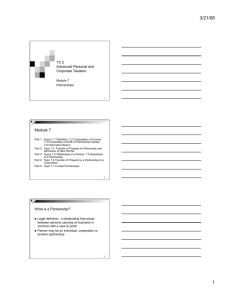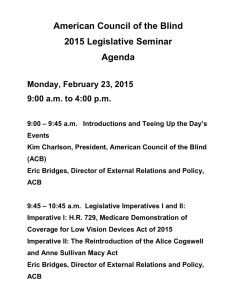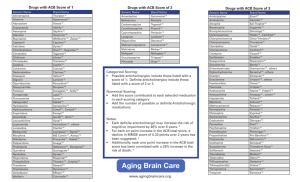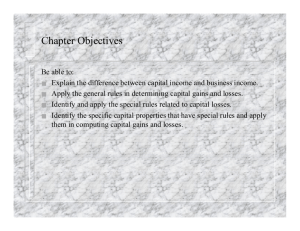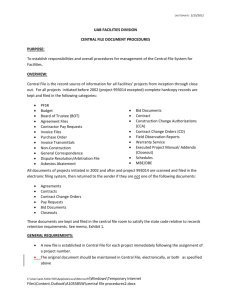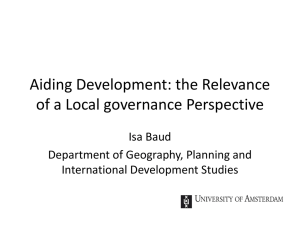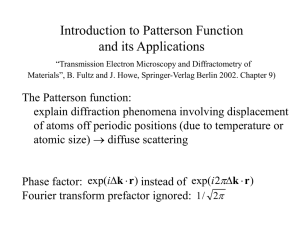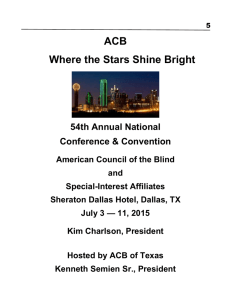Tx 2 Module 7 Partnerships The lecture for this lesson has been
advertisement
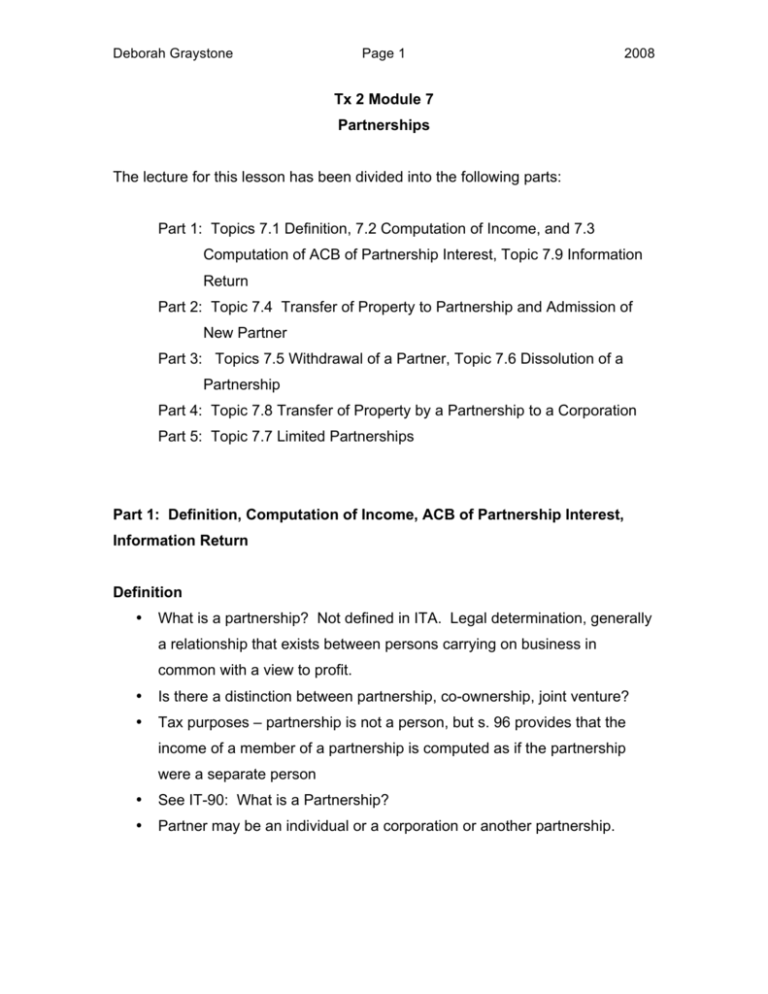
Deborah Graystone Page 1 2008 Tx 2 Module 7 Partnerships The lecture for this lesson has been divided into the following parts: Part 1: Topics 7.1 Definition, 7.2 Computation of Income, and 7.3 Computation of ACB of Partnership Interest, Topic 7.9 Information Return Part 2: Topic 7.4 Transfer of Property to Partnership and Admission of New Partner Part 3: Topics 7.5 Withdrawal of a Partner, Topic 7.6 Dissolution of a Partnership Part 4: Topic 7.8 Transfer of Property by a Partnership to a Corporation Part 5: Topic 7.7 Limited Partnerships Part 1: Definition, Computation of Income, ACB of Partnership Interest, Information Return Definition • What is a partnership? Not defined in ITA. Legal determination, generally a relationship that exists between persons carrying on business in common with a view to profit. • Is there a distinction between partnership, co-ownership, joint venture? • Tax purposes – partnership is not a person, but s. 96 provides that the income of a member of a partnership is computed as if the partnership were a separate person • See IT-90: What is a Partnership? • Partner may be an individual or a corporation or another partnership. Deborah Graystone Page 2 2008 Computation of Income • Basic concepts: S. 96(1): partnership computes its income as if it were a person. • Requires computation of income at the partnership level – not at the level of the individual partner. Most significant impact of this – CCA. • The income or loss calculated at the partnership level is then attributed to the partners according to the partnership agreement. This may or may not be equal to their interest in the partnership. Section 103 allows CRA to challenge allocation. • The income or loss allocated to the partners retains its source, i.e. if it was business income, investment income, capital gain, etc., to the partnership it will be the same to the partner. • Partners file tax returns and pay tax on partnership income – not partnership. Partnerships of more than 5 partners and limited partnerships must file information returns (Topic 7.9) • Fiscal period - paragraph 249.1(1)(b), a partnership with an individual or professional corporation as a member must have a December 31 yearend, unless alternate method elected. Other partnerships where no members are individuals or professional corporations can maintain fiscal periods which do not coincide with the calendar year. Partners must include in their income their share of the partnership income or loss earned during the fiscal period of the partnership ending in the fiscal period of the partner (December 31, if individual). Example, corporate partnership year-end October 31; corporate partner year-end September 30 – would include October 31, 2008 partnership income in taxable income for year-ended September 30, 2009. Can achieve tax deferral through selection of year-ends in non-individual/professional corporation situations. • See lesson notes Topic 7.2 for more specific computation of partnership income/loss issues Deborah Graystone • Page 3 2008 Special rules in section 125 limit the small business deduction available to corporations on their partnership income – specified partnership income. Computation of the ACB of a Partnership Interest • A partner owns a capital property, i.e., a partnership interest. Disposition of partnership interest – capital gain or loss. • Similar to shares, but as a partnership is not a legal person (unlike a corporation) its interests cannot be separated from the partners' interests. Therefore, a constant series of adjustments to the adjusted cost base (ACB) of the partners' interests in the partnership is necessary. • Almost all the partner’s transactions with the partnership will involve ACB adjustments. • Partnership interest ACB – important for determining tax consequences of dissolution of a partnership, withdrawal of partner, disposition of a partnership interest, or death of a partner. • Partnership interest ACB calculations – should be tracked annually for each partner. • Partnership ACB adjustments are provided for in paragraphs 53(1)(e) and 53(2)(c). • Not the same thing as accounting for partner capital accounts. • See readings notes Topic 7.3 for a useful check list of ACB adjustments. Starting point is capital contributions plus net income as calculated for tax purposes, i.e. after adjustments for book amortization/CCA, nondeductible expenses, plus 100% of capital gains, less capital withdrawals (draws), net loss for tax purposes, etc. etc. etc. • Negative ACB – usually because partner’s draws have exceeded income allocation or allocation of partnership losses in excess of capital contributions. Treated as a capital gain but usually only realized on disposition of the partnership interest. Limited partnerships – immediate capital gain. Deborah Graystone Page 4 2008 Part 2 – Transfer of Property to the Partnership and Admission of New Partner Transfer of Property: • May be done on formation of partnership or at any time • Transfer at FMV – disposition • Rollover available – subsection 97(2) – piggy-backs off S. 85. • Conditions for s. 97(2) rollover: Canadian partnership (all partners resident in Canada), transferor must be a partner of the partnership receiving the assets immediately after the transaction. • Consideration taken back – may include a partnership interest (doesn’t have to, unlike S. 85 which required at least 1 share must be taken back) • If agreed amount > consideration received, excluding partnership interest, difference is added to the ACB of the partner’s interest. • Form T2059 (similar to T2057 for S. 85). One partner files on behalf of the other partners (first partner required to file tax return). • Superficial Loss (s. 40(2)(g)(i)) – when majority interest partner transfers property to partnership and incurs capital loss, stop loss and added to ACB of property acquired by partnership. Partner and partnership are affiliated persons (s. 251.1(1)(f)) if partner holds majority interest Admission of New Partner • Under partnership law, a partnership dissolves if there is any change in the partners, unless the partnership agreement provides for the continuation of the partnership. Provision for the continuation of the partnership on the addition, withdrawal or death of a partner is standard in most partnership agreements. • New partner could enter partnership by acquiring partnership interest from one or more partners, contribute capital, or combination. If through acquisition of partnership interest, existing partners dispose of portion of interest with resulting capital gain or loss. No deemed disposition of Deborah Graystone Page 5 2008 partnership interest for existing partners if capital contribution and no ACB adjustment. Part 3: Withdrawal of Partner • Can be a difficult area • Many different ways for partner to withdraw: sale of partnership interest, buy-back of interest by partnership (redemption), retention of residual or income interest, or combination. Consequences to Partnership: • S. 98(6): permits a full rollover if a Canadian partnership ceases to exist and all of its property is transferred to another Canadian partnership whose partners were all partners in the old partnership. The new partnership is deemed to be a continuation of the old partnership. Applies only if all of the property of the old partnership is transferred to the new partnership. Consequences to Withdrawing Partner: • Sale of interest- capital gain/loss on disposition • Buy-back of Interest by partnership - Where the partner withdraws but retains for a period of time a right to receive property of the partnership in satisfaction of his interest (residual interest). Para 98.1(1)(a) the withdrawing partner is generally deemed not to have disposed of his interest in the partnership. Withdrawing partner may recover amounts taxfree up to his partnership interest ACB – further recoveries are capital gain as negative ACB taxed as capital gain in year it goes negative (not deferred until interest paid-out in full). See example 7-14. Deborah Graystone Page 6 2008 Income Interest in Partnership: • Could be arrangement to allocate future partner income to retired or deceased partner pursuant to partnership agreement (retirement income). Common in professional partnerships. • Subsection 96(1.1) provides that this type of payment is to be treated as a distribution of partnership profits for the purpose of subsection 96(1). • Retired partner deemed to continue to be member of partnership. Income retains its source, i.e. business income • Certain conditions must be met - see readings Dissolution of Partnership: • S. 98(2) - On dissolution, each property transferred to or taken by a partner is deemed to be disposed of by the partnership at fair market value. Tax implications: recapture of CCA, capital gains on the disposition of partnership assets to the partners, ACB adjustments. • S. 98(3) Rollover: election to permit a tax-free rollover of partnership property to the partners in certain circumstances – see lesson notes: Canadian partnership ceased to exist, all property distributed to partners, each person must have an undivided interest in each property distributed (restrictive provision) • Joint election - form T2060 • Partnership property deemed disposed of at cost amount – no gain or loss on dissolution • Partner deemed to dispose of partnership interest at greater of ACB of partnership interest or cash and % cost amount of property distributed. If at ACB, then no gain or loss • See example 7-15 in readings for comprehensive example Business Continued by One Partner: • Subsection 98(5) permits a tax-free rollover of assets from a discontinued partnership to a proprietorship. The rollover applies where, within three Deborah Graystone Page 7 2008 months of the termination of a Canadian partnership, one of the former partners commences to carry on the business of the previous partnership as a sole proprietor. Partnership property is received by him as proceeds of disposition of his partnership interest. • deems the member of the partnership who becomes the proprietor on a disposition by the other partners to have acquired partnership interests and not to have acquired partnership property. • Subsection 98(5) - not an elective provision - operates automatically when conditions are met. • See example 7-16 Part 4: Transfer of Property by Partnership to a Corporation • Rollover for Incorporation of partnership – s. 85(2) • Election form - T2058 • Subsection 85(3) – tax-free rollover where a partnership has transferred property to a corporation under s. 85(2), and the partnership is wound up within 60 days of the transfer, and the only assets of the partnership were cash and property received from the corporation as consideration for the disposition (shares) • In these circumstances subsection 85(3) provides a rollover treatment for the transfer of the consideration received from the corporation (including shares of the corporation) to the partners on the winding-up of the partnership. • See example 7-18 Part 5: Limited Partnerships (LP) • Usually used to limit legal liability and limit risk to amount invested (capital contribution), i.e. not jointly and severally liable for partnership’s acts, nor are they liable to compensate for losses incurred by LP • Common in real estate, tax shelter investments • Limited Partner – S. 96(2.4) definition Deborah Graystone • Page 8 2008 In many cases, it was not unusual for the limited partner to claim losses which were in excess of his monetary liability to the partnership. Considered to be abusive by tax authorities – introduced at-risk rules • subsections 96(2.1) to 96(2.7) limit the amount of losses which can be deducted by a limited partner for tax purposes, to the at-risk amount less certain deductions. • S. 96(2.2) - lengthy calculation of the at-risk amount. Essentially running total of capital contributions (ACB of initial investment) less write-offs allocated – see example 7-17 • Negative ACB of LP – realized capital gain at end of fiscal period of partnership in which ACB went negative
